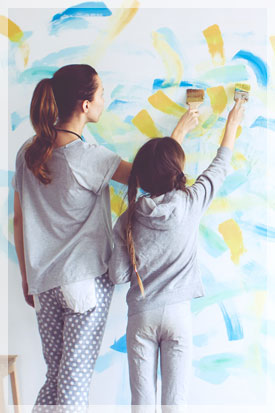23 Common Decorative Painting Techniques
 Looking to transform the look of a room at a minimal cost? Decorative painting does the trick. Forget about new materials being installed. Instead, a professional house painter like M. Brett’s team employs a combination of the following:
Looking to transform the look of a room at a minimal cost? Decorative painting does the trick. Forget about new materials being installed. Instead, a professional house painter like M. Brett’s team employs a combination of the following:
Broken Color: Manipulating a wet, glazed surface adds more variation to your wall.
Chalkboard Paint: Adding a few coats results in a washable and functional chalkboard on a flat wall.
Checkerboard: The contrasting diamond pattern imitates the look of marble floors for an elegant touch.
Color Washing: Visually, an ethereal hue is added on top of a solid shade. Technique wise, a paint and glaze combination goes on as a second coat.
Crackle: The undercoat shows from beneath. To do this, the painter adds a rapidly-drying top coat over a slow-drying base coat.
Dry-Brushing: Paint gives your walls a textured look to imitate wood.
Flogging: Using a long-bristled brush to slap the surface creates the look of wood pores.
Fresco: Your walls take on the look of parchment. A mottled appearance is achieved through a technique similar to color-washing involving a lime wash.
Frottage: A painter rubs wet glaze with fabric to create a textured surface.
Glazing: Paint and glaze are mixed together for a translucent effect.
Glitter: The paint contains reflective elements that catch the light. May be applied as a top coat or veil.
Gradient: The painter gives your wall the look of one color transitioning to another.
Ragging: The wall’s hue shifts from one color to another. What results is a well-worn, almost leathery appearance.
Smooshing: Add a marbled effect to your walls. Similar to Moire.
Sponging: Give your walls the appearance of porcelain or stoneware.
Stipple: Glaze is applied as tiny dots. The technique eliminates brush strokes and gives the paint an even film.
Strié: Accent colors applied through a glazing technique contrast with the base shade. In some cases, the wall’s surface resembles the texture of linen.
Stripes: Two shades – subtle or contrasting – increase the textural element.
Texture: Painting techniques create a sand- or stone-like look.
Trompe L’Oeil: Your walls are painted to have the illusion of depth.
Venetian Plaster: A multi-layer painting technique replicates the look of marble walls in a Roman palace.
Wood Graining or Faux Bois: The painter drags a tool over the wet surface. What results resembles wood graining.
Harlequin: A diamond pattern is painted or stenciled onto the wall.
Considering decorative painting or a faux finish for your home? M. Brett Painting offers such services in Connecticut and the rest of New England. Contact our location to find out more.
